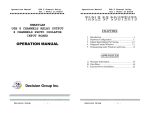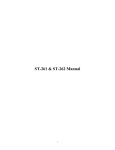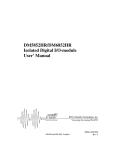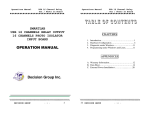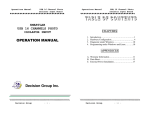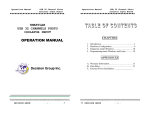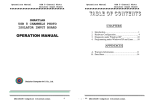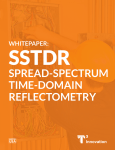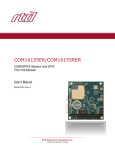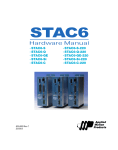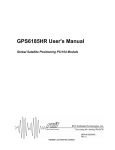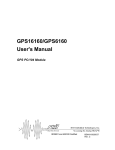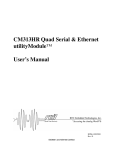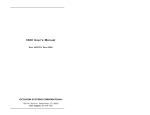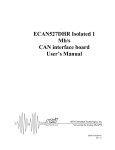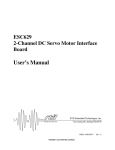Download DM6854 Isolated Digital I/O dataModule User`s Manual
Transcript
DM6854 Isolated Digital I/O dataModule User’s Manual ISO9001 and AS9100 Certified BDM-610010032 Rev. B DM6854 User’s Manual RTD Embedded Technologies, Inc. 103 Innovation Blvd. State College, PA 16803-0906 Phone: +1-814-234-8087 FAX: +1-814-234-5218 E-mail [email protected] [email protected] web site http://www.rtd.com Copyright 1999-2010 RTD Embedded Technologies, Inc. All rights reserved The RTD Logo is a registered trademark of RTD Embedded Technologies. cpuModule and dataModule are trademarks of RTD Embedded Technologies. PC/104 is a registered trademark of PC/104 Consortium. All other trademarks appearing in this document are the property of their respective owners. Page 2 of 33 DM6854 User’s Manual Manual Revision History Rev. A New RTD USA Manual Rev. B RTD ISA ID added Added AS9100 Information Updated board photo to current PCB revision Updated jumper diagrams to match Added information on CN9 Replaced PC/104 connector pinout with a link to PC/104 Consortium Corrected description of isolated input inversion Added Dimension Drawing Page 3 of 33 DM6854 User’s Manual TABLE OF CONTENTS CHAPTER 1 INTRODUCTION............................................................................................................................ 6 FEATURES...................................................................................................................................................................6 GENERAL PURPOSE DIGITAL I/O..................................................................................................................................6 ISOLATED DIGITAL INPUTS ..........................................................................................................................................6 ISOLATED DIGITAL OUTPUTS .......................................................................................................................................6 MECHANICAL DESCRIPTION ........................................................................................................................................6 CONNECTOR DESCRIPTION ..........................................................................................................................................7 WHAT COMES WITH YOUR BOARD .............................................................................................................................. 7 BOARD ACCESSORIES .................................................................................................................................................7 USING THIS MANUAL...................................................................................................................................................7 WHEN YOU NEED HELP ...............................................................................................................................................7 CHAPTER 2 CONFIGURING THE DATAMODULE .......................................................................................8 FACTORY-CONFIGURED JUMPER SETTINGS ................................................................................................................8 BASE ADDRESS (JP9) .................................................................................................................................................9 INTERRUPT CHANNEL (JP10) ....................................................................................................................................10 PD/PU PULL-UP OR PULL-DOWN RESISTOR SELECTION ............................................................................................ 10 IN1-IN8 OPTOCOUPLER INPUT RANGE .....................................................................................................................11 CHAPTER 3 INSTALLING THE DATAMODULE .........................................................................................12 RECOMMENDED PROCEDURE ...................................................................................................................................12 CHAPTER 4 CONNECTING THE DATAMODULE.......................................................................................13 FINDING PIN 1 OF CONNECTORS ............................................................................................................................... 13 ISOLATED I/O CONNECTIONS, JP15 & JP16 ..............................................................................................................13 EXPANSION INTERFACE CONNECTIONS, JP14 ...........................................................................................................14 PC/104 BUS CONNECTORS, CN1 AND CN2 ..............................................................................................................14 RESERVED CONNECTOR, CN9 ..................................................................................................................................14 CHAPTER 5 HARDWARE DESCRIPTION .....................................................................................................15 DIGITAL I/O, PROGRAMMABLE PERIPHERAL INTERFACE (PPI) .................................................................................15 ISOLATED OPTOCOUPLER INPUTS .............................................................................................................................. 16 Input Protection ...................................................................................................................................................16 Optocouplers .......................................................................................................................................................16 Input bit mask stage .............................................................................................................................................16 Input bit inverter stage ........................................................................................................................................16 ISOLATED OPTOCOUPLER OUTPUTS ........................................................................................................................... 17 Output data register.............................................................................................................................................17 Schmidt triggers ...................................................................................................................................................17 Optocouplers .......................................................................................................................................................17 TRIGGER OUTPUT......................................................................................................................................................17 INTERRUPTS.............................................................................................................................................................. 17 CHAPTER 6 BOARD OPERATION AND PROGRAMMING .......................................................................18 DEFINING THE I/O MAP ............................................................................................................................................18 BA+0 Digital input register (Write) ................................................................................................................18 BA+0 Digital inputs (Read) ........................................................................................................................... 18 BA+1 Input mask register (Read / Write) 0 after reset...................................................................................18 BA+2 Input inversion register (Read / Write) 0 after reset .............................................................................19 BA+3 Configuration / digital output register (Read / Write) 0 after reset ......................................................19 Page 4 of 33 DM6854 User’s Manual BA+4 PPI Port A (Read/Write) ......................................................................................................................19 BA+5 PPI Port B (Read/Write) .....................................................................................................................19 BA+6 PPI Port C (Read/Write) ......................................................................................................................20 BA+7 PPI Control Byte (Write only) ............................................................................................................20 BA + 400h/BA + 401h RTD ID Data (read only, 8-bit or 16-bit) .......................................................................21 BA + 402h RTD ID Reset Pointer (read only, 8-bit only) ...................................................................................21 RTD ID Data Read Indexes .................................................................................................................................21 PROGRAMMING THE DM6854HR ............................................................................................................................. 21 Clearing and setting bits in an I/O port ...............................................................................................................22 Initializing the 8255 PPI......................................................................................................................................22 Isolated digital input programming .....................................................................................................................22 Software controlled direct read ........................................................................................................................22 Interrupt driven read upon change in bits ........................................................................................................23 Isolated digital output programming ...................................................................................................................23 Trigger output programming ............................................................................................................................... 23 Interrupts ............................................................................................................................................................. 23 What is an interrupt? ........................................................................................................................................23 Interrupt request lines ......................................................................................................................................24 8259 Programmable Interrupt Controller .........................................................................................................24 Interrupt Mask Register (IMR) ........................................................................................................................24 End-of-Interrupt (EOI) Command ...................................................................................................................24 What exactly happens when an interrupt occurs? ............................................................................................ 24 Using Interrupt in your Program ......................................................................................................................25 Writing an Interrupt Service Routine (ISR) .....................................................................................................25 Saving the Startup Interrupt Mask Register (IMR) and interrupt vector .......................................................... 26 Common Interrupt mistakes ............................................................................................................................. 27 Example of Interrupt vector table setup in C-code: .........................................................................................27 CHAPTER 7 SPECIFICATIONS........................................................................................................................29 GENERAL SPECIFICATIONS ........................................................................................................................................29 Interface ............................................................................................................................................................... 29 Digital I/O (non isolated) ....................................................................................................................................29 Digital inputs (isolated) .......................................................................................................................................29 Digital outputs (isolated) .....................................................................................................................................29 Connectors ........................................................................................................................................................... 29 DC CHARACTERISTICS..............................................................................................................................................30 DIMENSION DRAWING ..............................................................................................................................................31 CHAPTER 8 RETURN POLICY AND WARRANTY ......................................................................................32 RETURN POLICY .......................................................................................................................................................32 LIMITED WARRANTY ................................................................................................................................................32 Page 5 of 33 DM6854 User’s Manual Chapter 1 INTRODUCTION This user's manual describes the operation of the DM5854HR/DM6854HR Isolated Digital Interface board. Features 8 channel-by-channel isolated digital inputs with masking modes 4 Optocoupled digital outputs with open collector configuration, 30V range 24 non isolated TTL/CMOS compatible 8255-based digital I/O lines Optional Pull-up or Pull-down resistors Software enabled interrupts XT and AT interrupts available Single +5V operation Support for direct PC/104 interface with RTD dataModules® XT (DM5854HR) and AT (DM6854HR) boards available PC/104 compliant RTD IDAN compatible The following paragraphs briefly describe the major features of the DM6854HR. A more detailed discussion is included in Chapter 5 (Hardware description) and in Chapter 6 (Board operation and programming. The board setup is described in Chapter 2 (Configuring the dataModule). General purpose digital I/O The DM6854HR board has 24 8255-based TTL/CMOS compatible general purpose digital I/O lines which can be directly interfaced with external devices or signals to interface to alphanumerical displays, sense switch closures, trigger digital events, or activate solid-state relays. These lines may be pulled down or pulled up or pulled down with 10K Ohm resistor networks. Installation procedures will be described later in this manual. Isolated digital inputs Eight optocoupler inputs may be used to connect high voltage signals to a computer. Eight channel-by-channel jumper configurable input ranges are available: +5V, +12V and +24V. The optocoupler inputs have a reverse voltage protection diode across the input. This enables ACsignals to be connected to the isolated optocoupler inputs. This input diode also acts as a rectifier. The programmable functions of the DM6854HR enable input masking and input pattern recognition with interrupts. This relieves the host computer from processor capacity consuming input polling. Isolated digital outputs Four open collector optocoupler outputs may be used to directly drive loads such as switches or relays with voltages up to 30V DC. Mechanical description The DM6854HR is designed on a PC/104 form factor. An easy mechanical interface to both PC/104 and PC/104-Plus systems can be achieved. Stack your PC/104 compatible computer Page 6 of 33 DM6854 User’s Manual directly on the DM6854HR using the onboard mounting holes. A dimension drawing with connector locations is provided in Chapter 7. Connector description There is a 50 pin digital interface connectors on the DM6854HR to directly interface to the nonisolated 8255-based digital I/O signals. The signal definition of this connector is compatible with the digital PC/104 dataModules manufactured by RTD. Isolated outputs and inputs are connected to the DM6854HR by either a screw terminal discrete wire connector, or with a 50-pin flat ribbon cable header connector. Use this type of interface connector with a TB50 screw terminal block. Please consult the factory for more details on different connector options. What comes with your board You receive the following items in your DM6854HR package: DM6854HR Isolated digital interface module Companion CD Notes: Latest software and drivers can be downloaded from our website. If any item is missing or damaged, please contact RTD Embedded Technologies. Board accessories Several software and hardware accessories are available for the DM6854. Call your distributor for more information on these accessories and for help in choosing the best items to support your control system, Application software and drivers Hardware accessories such as IDAN aluminum enclosure systems. For more information in IDAN please visit our websites at www.rtd.com. Power Supplies Terminal Adapter Board (TB50) Using this manual This manual is intended to help you install your new DM6854HR card and get it running quickly, while also providing enough detail about the board and its functions so that you can enjoy maximum use of its features even in the most demanding applications. When you need help This manual and all the example programs will provide you with enough information to fully utilize all the features on this board. If you have any problems installing or using this board, contact our Technical Support Department (814) 234-8087 during EST business hours, or send an Email to [email protected]. When sending an Email request, please include your company's name and address, your name, your telephone number, and a brief description of the problem. Page 7 of 33 DM6854 User’s Manual Chapter 2 CONFIGURING THE DATAMODULE The following sections contain information on configuring the dataModule. Please read this entire section before attempting to use the dataModule. The DM6854HR Isolated digital I/O board has jumper settings that you can change to suit your application and I/O configuration setup. Factory-Configured Jumper Settings Table 2.1 illustrates the factory jumper setting for the DM6854HR. Figure 2.1 shows the board layout and the locations of the jumpers. The following paragraphs explain how to change the factory jumper settings to suit your specific application. Table 2.1: Factory Default Jumper Settings Jumper Name BASE (JP9) IRQ (JP10) PD/PU IN1-8 Description Base Address Interrupt Selection Pullup or Pulldown for PPI Ports Input Range for Isolated input 1-8 Number of Jumpers 5 12 (11+1) 3-terminal (4x) 3 (8x) Factory Default 0x300 IRQ5, G Pulldown +24V Figure 2.1: Board layout showing jumper locations Page 8 of 33 DM6854 User’s Manual Base Address (JP9) (Factory setting: 300h) The most common cause of failure when you are first setting up your module is address contention. Some of your computers I/O space is already occupied by other internal I/O devices and expansion boards. When the DM6854HR attempts to use its reserved I/O addresses already used by another peripheral device erratic performance may occur and data read from the board may be corrupted. To avoid this problem make sure you set up the base address first using the jumpers marked "BASE" which let you choose from 32 different I/O addresses in your computers I/O map. Should the factory installed setting of 300H be unusable for your system configuration, you may change this setting to another using the options illustrated in Table 2.2. The table shows the jumper settings and their corresponding I/O address in values hexadecimal and decimal. Make sure you verify the correct location of the base address jumpers Table 2.2: Base Address Jumper Settings Base Address Hex / (Decimal) 200/(512) 210/(528) 220/(544) 230/(560) 240/(576) 250/(592) 260/(608) 270/(624) 280/(640) 290/(656) 2A0/(672) 2B0/(688) 2C0/(704) 2D0/(720) 2E0/(736) 2F0/(752) Jumper Settings A8 – A4 00000 00001 00010 00011 00100 00101 00110 00111 01000 01001 01010 01011 01100 01101 01110 01111 Base Address Hex / (Decimal) 300/(768) 310/(784) 320/(800) 330/(816) 340/(832) 350/(848) 360/(864) 370/(880) 380/(896) 390/(912) 3A0/(928) 3B0/(944) 3C0/(960) 3D0/(976) 3E0/(992) 3F0/(1008) Jumper Settings A8 – A4 10000 10001 10010 10011 10100 10101 10110 10111 11000 11001 11010 11011 11100 11101 11110 11111 Figure 2.2: Base Address jumper block (A4 to top, A8 to bottom; open = 0, closed = 1) Page 9 of 33 DM6854 User’s Manual Interrupt channel (JP10) (Factory setting: IRQ5, G) The header connector, shown on Figure 2.3 lets you connect the board interrupt to one of the 6 interrupt channels available on the XT/AT-bus. The ―G‖ setting installs a pull-down resistor on the selected interrupt. The ―G‖ jumper is used to share an IRQ line between multiple devices. Figure 2.3: Interrupt Selection Jumpers Note: There must be exactly one ―G‖ jumper installed on any interrupt line. The interrupt is caused by an external trigger event that has transferred the storage latch data to the output latch of the isolated digital output stage. PD/PU Pull-up or Pull-down resistor selection (Factory setting: PA, PB and PC pulled ―Low‖) The 8255 programmable digital I/O interface provides 24 TTL/CMOS compatible lines which can be interfaced with external devices. These lines are divided into three groups: eight Port A lines, eight Port B lines and eight Port C lines. You can connect pull-up or pull-down resistor networks for ports A, B and C. There is a separate jumper for the upper four lines of Port C, and one for the lower four lines. You may want to pull lines up for connection with switches. This will pull the lines high if the switch is disconnected. Or you may want to pull lines down for connection to relays which control turning motors on or off. The port A, B, and C lines of the 8255 programmable digital I/O interface are set as inputs after reset. This can cause the external devices connected to these lines to operate erratically. Pulling these lines down, when the board is powered up the lines will not be active before the 8255 is initialized. Figure 2.4 shows both Ports A, B and C set in the Pull-down configuration. Figure 2.4: Pull-up and Pull-down jumpers for Ports A, B and C. Page 10 of 33 DM6854 User’s Manual IN1-IN8 Optocoupler Input Range (Factory setting: +24V range) The Optocoupler inputs can be jumper configured for different input ranges. Each channel can be set for a different range. The different ranges use different current limiting resistors at the optocoupler diode input. Make sure you set the range correctly since overloading the optocoupler with over current may cause permanent damage to the device. All the channels are set in a similar manner. Figure 2.5 illustrates one channel set for a 24V-level input signal. The jumper topmost toward the spring loaded connectors selects +24V input range, the middle position +12V and the bottom most (toward the center of the board) +5V. The optocoupler forward current is 0.13 mA for switching. Figure 2.5: Optocoupler Input Range Jumpers set for 24V input range Page 11 of 33 DM6854 User’s Manual Chapter 3 INSTALLING THE DATAMODULE Recommended Procedure We recommend you follow the procedure below to ensure that stacking of the modules does not damage connectors or electronics. Turn off power to the PC/104 system or stack. Select and install standoffs to properly position the dataModule on the PC/104 stack. Touch a grounded metal part of the stack to discharge any buildup of static electricity. Remove the dataModule from its anti-static bag. Verify the jumper settings of the dataModule. Check that keying pins in the PC/104 bus connector are properly positioned. Hold the dataModule by its edges and orient it so the bus connector pins line up with the matching connector on the stack. Gently and evenly press the dataModule onto the PC/104 stack. CAUTION: Do not force the module onto the stack! Wiggling the module or applying too much force may damage it. If the module does not readily press into place, remove it, check for bent pins or out-of-place keying pins, and try again. Page 12 of 33 DM6854 User’s Manual Chapter 4 CONNECTING THE DATAMODULE The following sections describe connectors of the dataModule. Finding Pin 1 of Connectors A white area silk-screened on the PC board indicates the pin 1 end of connectors. A square solder pad visible on the bottom of the PC board also indicates it. Please make certain you have correctly identified pin 1 of a connector before you connect to it and attempt to use the dataModule. Isolated I/O connections, JP15 & JP16 The pin assignments for the isolated I/O are shown in Table 4.1. The DM6854 is available with either a terminal block connection, or a 48 pin header connection. In the 48 pin header configuration, each column of the header is connected to the same signal, i.e. pin 1 and 2 are both IN1+. Pin 1 is to the left side of the connector (when board is oriented as in Figure 2.1). ALL SIGNALS ARE ISOLATED Table 4.1: Isolated I/O Pin Assignments Terminal Block Pin 1 2 3 4 5 6 7 8 9 10 11 12 13 14 15 16 17 18 19 20 21 22 23 24 Header Pin 1,2 3,4 5,6 7,8 9,10 11,12 13,14 15,16 17,18 19,20 21,22 23,24 25,26 27,28 29,30 31,32 33,34 35,36 37,38 39,40 41,42 43,44 45,46 47,48 Description IN1+ IN1IN2+ IN2IN3+ IN3IN4+ IN4IN5+ IN5IN6+ IN6IN7+ IN7IN8+ IN8OUT1_COLLECTOR OUT1_EMITTER OUT2_COLLECTOR OUT2_EMITTER OUT3_COLLECTOR OUT3_EMITTER OUT4_COLLECTOR OUT4_EMITTER Page 13 of 33 DM6854 User’s Manual Expansion Interface Connections, JP14 Figure 2-4 shows the 50-pin expansion interface connector layout of the DM6854HR. This connector is used to interface to the non-isolated 8255 based digital I/O signals. Table 4.2: 50-pin expansion interface connector pinout Pin Description Description Pin 1 3 5 7 9 11 13 15 17 19 21 23 25 27 29 31 33 35 37 39 41 43 45 47 49 Port_C(0) Port_C(1) Port_C(2) Port_C(3) Port_C(4) Port_C(5) Port_C(6) Port_C(7) Port_B(0) Port_B(1) Port_B(2) Port_B(3) Port_B(4) Port_B(5) Port_B(6) Port_B(7) Port_A(0) Port_A(1) Port_A(2) Port_A(3) Port_A(4) Port_A(5) Port_A(6) Port_A(7) +5V(fused) Ext_Trigger(Output) GND GND GND GND GND GND GND GND GND GND GND GND GND GND GND GND GND GND GND GND GND GND GND GND 2 4 6 8 10 12 14 16 18 20 22 24 26 28 30 32 34 36 38 40 42 44 46 48 50 PC/104 Bus Connectors, CN1 and CN2 Connectors CN1 and CN2 provide PC/104 bus connections. CN1 carries XT bus signals, and CN2 carries additional signals for the AT bus. The signals on CN1 and CN2 conform to the IEEE P966 standard for the PC/104 bus. The PC/104 connector pinout may be found at www.pc104.org. Note: Two locations on the bus have mechanical keying pins to help prevent misconnection of the PC/104 bus. These keying pins are a part of the PC/104 standard, and we strongly recommend you leave them in place. If you have other modules without keying pins, we suggest you modify them to include keying. Reserved Connector, CN9 CN9 is reserved for factory use. Nothing should be attached to this connector. Page 14 of 33 DM6854 User’s Manual Chapter 5 HARDWARE DESCRIPTION This chapter describes the major features of the DM6854HR: the 8255 based digital I/O, isolated optocoupler inputs, isolated optocoupler outputs, interrupts and output triggering. Figure 5.1 shows the general block diagram of the DM6854HR. Figure 5.1: DM6854HR Block diagram Digital I/O, Programmable Peripheral Interface (PPI) The programmable peripheral interface (PPI) is used for general purpose digital I/O functions. This high performance TTL/CMOS compatible chip has 24 digital I/O lines divided into two groups of 12 lines each. Group A: Port A (8) lines and Port C upper (4) lines Group B: Port B (8) lines and Port C lower (4) lines Port A, Port B and Port C are available at the 50 pin expansion connector. You can use Ports A, B and C in one of these three operating modes: Mode 0: Basic I/O. Lets you use simple input output functions for a port. Data is written to or read from the specified port Mode 1: Strobed Input/Output. Lets you transfer data I/O from port A in conjunction with strobed or handshake signals. Page 15 of 33 DM6854 User’s Manual Mode 2: Strobed bi-directional input/output. Lets you communicate with an external device through port A. Handshaking is similar to mode 1. Available Port direction definitions: Port A may be Inputs or Outputs Port C lower bits may be Inputs or Outputs Port C higher bits may be Inputs or Outputs All these modes are discussed in detail in the 8255 datasheet from Intel. Isolated optocoupler inputs The Isolated input stage of the DM6854HR consists of 4 major parts: Input protection Input optocouplers Input bit mask stage Input bit inverter stage. Input Protection The input circuitry of the DM6854HR consists of a range selection jumper field and an input protection Schottky diode. The optocoupler is current driven, so the input range is selected by connecting different current limiting resistors in series with the optocoupler input diode. To protect the optocoupler input diode from over current and reverse voltage, a diode is connected in reverse with the optocoupler input diode. Make sure you do not exceed the absolute maximum voltage of each nominal input range. Exceeding this limit may cause permanent damage to the optocouplers. Optocouplers The SMD-optocouplers provide the galvanic isolation between the computer and the process signals as well as isolation between input channels. The optocouplers are logically inverting, i.e. a voltage on the isolated digital input will be interpreted as a logical "0". To avoid false triggering on the inputs special "Schmidt trigger" buffers are used to provide reliable and precise switching of the inputs. Input bit mask stage The programmable input processing section of the DM6854HR includes an input bit mask filter stage. This mask may be is used to select bits or groups of interesting bits for pattern recognition. Bit selection is performed by writing to the mask register (BA+1). A bit is selected for comparison if it is set to one "1". The currently active mask can be read back from the same address (BA+1). After reset condition all bits are "0" and disabled. Input bit inverter stage The trigger logic of the DM6854HR uses OR-logic from the inputs. This means that a transition from low to high on any input will cause a trigger condition. To enable bitwise selection of the polarity of the signals an inverter stage may be used. Bit inversion is performed by writing to the Page 16 of 33 DM6854 User’s Manual input inversion register (BA+2). An input channel is inverted by writing "1" to the corresponding inversion register bit. Example: outp(BA+2,0x0f); will invert input channels 1-4. Isolated optocoupler outputs The Isolated optocoupler output stage of the DM6854HR consists of 3 major parts: Output data register Schmidt triggers Optocouplers. Output data register The four bit output register holds the output pattern for the output stage. Data can be updated and read from address (BA+3), bits 4-8. The lower bits (1-4) hold the configuration bits of your DM6854HR. Make sure these bits are unchanged when writing to this register. To avoid accidental changes in configuration, read the data in the register (BA+3) before writing to it. Schmidt triggers The output of the optocoupler has a Schmidt trigger to condition the output of the optocouplers, this will reduce false triggering. Optocouplers Small SMD-optocouplers are used to isolate each channel of the isolated outputs. Individual optocouplers are used for each channel. The optocouplers are directly connected to the Output data register. The optocouplers are connected in a non inverting configuration in open collector configuration. The maximum switching current is 8mA at 30V. Trigger output Your DM6854HR is capable of generating a trigger signal caused by an input condition. This feature is especially useful when monitoring for a predefined input condition. When this predefined condition occurs, an interrupt will indicate this condition to the host. This trigger is also available as an external output signal on the 50-pin connector Pin #2. You may use this to trigger other devices or other boards in your system such as the isolated digital output board and DM6854HR. The polarity of this trigger signal is programmable and is driven by a tristate buffer. This enables several boards to drive the same trigger output signal. Interrupts The DM6854HR has an interrupt available to indicate an external trigger. This interrupt can be used to tell the host computer that the pre-programmed input pattern condition has occurred. Chapter 6 will provide programming information on interrupts. Page 17 of 33 DM6854 User’s Manual Chapter 6 BOARD OPERATION AND PROGRAMMING This chapter shows you how to program and use your DM6854HR. It provides a complete detailed description of the I/O-map and a detailed discussion of programming operations to aid you in application programming. Defining the I/O Map The I/O map of the DM6854HR is shown in Table 4-1 below. As shown the module occupies 8 addresses. The Base Address (designated as BA) can be set using the jumpers as described in Chapter 1, Module Settings. The following sections describe the register contents of each address used in the I/O map. Table 6.1: DM6854HR I/O Map Address Read Function Write Function BA + 0 BA + 1 BA + 2 BA + 3 BA + 4 BA + 5 BA + 6 BA + 7 BA+400h BA+401h BA+402h Digital Inputs 1-8 Read Input Mask Read Input Inversion Register Read Configuration / Output Register 82C55 Read Port A Data 82C55 Read Port B Data 82C55 Read Port C Data Reserved RTD ID Data (Read next Character) RTD ID Data (Read next Character) Reset RTD ID (Reset counter) Clear IRQ / Trigger Write Input Mask Write Input Inversion Register Write Configuration / Output Register 82C55 Write Port A Data 82C55 Write Port B Data 82C55 Write Port C Data 82C55 Write to Control Byte n/a n/a n/a BA+0 Digital input register (Write) The trigger condition is latched on the DM5854/6854. The interrupt request will remain high until the host acknowledges the interrupt. This is done with a write to BA+0. Example: BA+0 Digital inputs outp(BA,data); // Clears trigger and interrupt; data is irrelevant (Read) The eight isolated digital input bits available in connector J4 can be read from address BA+0. BA+1 Input mask register (Read / Write) 0 after reset The input mask register selects which bits are monitored for a trigger condition. A "1" corresponds to a selected bit. Example: outp(BA+1, 0x7F); // Bits 1-7 are selected Page 18 of 33 DM6854 User’s Manual BA+2 Input inversion register (Read / Write) 0 after reset The input inversion register may be used to invert input channels selected by the input mask register. If a logical 0 on the input bit is should cause a trigger; the respective inversion bit should be set (to "1‖). Example: Bits 1-7 are monitored for a condition where any bit changes state from condition 0x3E. Step 1: Mask required bits outp(BA+1,0x7F); // 0 1 1 1 1 1 1 1 Step 2: Set inversion register outp(BA+2,0x3E); // 0 0 1 0 1 1 1 0 BA+3 Configuration / digital output register BIT 0 (Read / Write) 0 after reset 1 -> External host IRQ enabled 0 -> External host IRQ disabled BIT 1 1 -> External trigger output (50-pin header, pin 2) tristate buffer enabled 0 -> External trigger output tristate buffer in tristate (externally pulled low) BIT 2 1 -> External trigger output active low 0 -> External trigger output active high BIT 3 1 -> Interrupt/trigger active (Read only) 0 -> Interrupt/trigger not active (Read only) BITS 4-7 BA+4 PPI Port A 4-bit isolated digital output port (Read/Write) Transfers the 8-bit Port A digital input and output data between the module and an external device. A read transfers data from the external device, through connector J5, and into port A; a write transfers the written data from port A through J5 to the external devices. BA+5 PPI Port B (Read/Write) Transfers the 8-bit Port B digital input and output data between the module and an external device. A read transfers data from the external device, through connector J5, and into port B; a write transfers the written data from port B through J5 to the external devices. Page 19 of 33 DM6854 User’s Manual BA+6 PPI Port C (Read/Write) Transfers the 4-bit low nibble of the Port C digital input and output data between the module and an external device. A read transfers data from the external device, through connector J5, and into bits 0-7 of port C; a write transfers the written data bits 0-7 from port C through J5 to the external devices. BA+7 PPI Control Byte (Write only) Table 6.2: Control Byte, Control Word Mode Bit Name D7 Mode Set Flag Description D6-D5 Mode select for group #1 1 = Active When bit 7 is set to 1, a write programs the PPI configuration. Group # 1 D4 Direction of Port A D3 Direction of Port C Upper (bits 4-7) D2 Mode select for group #2 D1 Direction of Port B D0 Direction of Port C Lower (bits 0-3) D6 D5 0 0 0 1 1 1 0 = Output 1 = Input 0 = Output 1 = Input Mode Mode 0 Mode 1 Mode 2 Group # 2 0 = Mode 0 1 = Mode 1 0 = Output 1 = Input 0 = Output 1 = Input Table 6.3: Control Byte, Bit Set Mode Bit Name Description D7 Mode Set Flag D6-D4 D3-D1 Reserved Bit Select 0 = Active When bit 7 is set to 0, a write can program individual lines of port C. Can be any value D3 0 0 0 0 1 1 1 1 D2 D1 0 0 1 1 0 0 1 1 0 1 0 1 0 1 0 1 Bit Select PC0 PC1 PC2 PC3 PC4 PC5 PC6 PC7 Page 20 of 33 DM6854 User’s Manual D0 Value 0 = Set bit to 0 1 = Set bit to 1 BA + 400h/BA + 401h RTD ID Data (read only, 8-bit or 16-bit) RTD ID is a method to identify a board on the ISA bus. There are two 8-bit registers mapped at and . The registers can be read as two 8-bit or one 16-bit. An internal pointer is auto-incremented with every read to either address so the data read will step through each index as indicated below. The pointer is set to zero at reset and can be reset to zero by a read to . BA + 402h RTD ID Reset Pointer (read only, 8-bit only) A read to will set the internal pointer to zero. The pointer is set to zero at reset. RTD ID Data Read Indexes Index 0 1 2 3 4 5 6–9 10 11 12 13 14 15 16 17 18-255 Data Device ID Device ID RTD Vendor ID RTD Vendor ID EPLD Revision EPLD Revision Reserved Board Name String Board Name String Board Name String Board Name String Board Name String Board Name String Board Name String Board Name String Unused 8-Bit Read 545h 68h 35h 14h Revision LSD Revision MSD Ignore D M 6 8 5 4 <nul> <nul> FFh 16-Bit Read 6854h — 1435h — Revision — Ignore DM — 68 — 54 — <nul><nul> — FFFFh Programming the DM6854HR This section gives you some general information about programming the DM6854HR board, and then walks you through the major programming functions of the board. These descriptions will help you as you use the example programs and function libraries included with this board. All of the program descriptions use decimal values unless otherwise specified. The DM6854HR is programmed by writing to and reading from the correct I/O-port addresses of the board. These I/O ports were described in the previous section of this chapter. The following example shows how to perform a 8-bit read and write I/O port addresses using"C"-syntax and assembly code: Table 6.4: Code Examples Read Write Page 21 of 33 DM6854 User’s Manual “C” Syntax Assembly var = inp(address); mov dx,address in ax,dx outp(address,data); mov dx,address mov ax,data out dx,ax Clearing and setting bits in an I/O port When you clear or set bits in an I/O port you must be careful not to alter the status of other bits. You can preserve the status of all the bits you do not wish to change by proper use of the bitwise AND- and OR-operators. Using and or operators, single or multiple bits can easily be set or cleared in one line operations. To clear a single bit in a port, AND the current value of the port with the value "B" , where B = 255-2(exp) bit. To set a single bit in a port, OR the current value of the port with the value "B", where B = 2(exp) bit. Bits are numbered from 0-7 for the low byte of a word and from 8-15 for the high byte of a word. Setting and clearing of multiple bits in a bye or word is more complex. To clear multiple bits in a port, AND the current value of the port with the value "B", where B = 255-(the sum of the values of the bits to be cleared). Note that the bits do not have to be consecutive. To set multiple bits in a port, OR the current value of the port with the value "B", where B = (sum of the individual bits to be set). Initializing the 8255 PPI Before you can operate the non isolated general purpose digital I/O through the 8255 PPI it must be initialized. This step must be performed every time you start up, reset or reboot your computer. The 8255 PPI is initialized by writing the appropriate control byte to the I/O Port BA+7 The contents of your control word will vary, depending on how you want to configure your I/O lines. Use the control word description in the previous I/O map section to help you program the right value. Example: Port A -> Output Port B -> Output Port C Upper -> Input Port C Lower -> Output Control Byte : 88h Isolated digital input programming The optoisolated digital inputs may be addressed directly by reading the digital input register in address (BA+0). The DM6854HR features more advanced modes of input pattern or bit change recognition to reduce software overhead. This is possible with the hardware interrupt generated by the onboard comparison logic.The following two subsections will illustrate how to program the different modes of the isolated digital input port. Software controlled direct read Page 22 of 33 DM6854 User’s Manual in_data=inp(BA); // Loads data from inputs into variable in_data Interrupt driven read upon change in bits mask = 0x55; // Odd bits are of interest state = 0x01; // Any of bits 3,5,7 goes high or bit 1 goes low outp(BA+1,mask) // Program mask register outp(BA+2,state); // Program bit inversion register outp(BA+3,0x01); // Enable interrupts outp(BA,0x00); // Clear hardware interrupt , if state had already occurred // Now if any of bits 3,5,7 goes high or bit 1 goes low it will cause a // hardware interrupt. In your ISR. you will read the input data with // "in_data = inp(BA);". Isolated digital output programming The four bit digital output port can directly be programmed from software by writing output data to the high bits (4-8) of I/O-port address BA+3. Care must be taken to ensure the lower four bits remain unchanged since they hold the configuration data of your DM6854HR. The example below illustrates a safe way of controlling the digital outputs. Example in "C" syntax: // Step 1 store the current contents of the Control/Output register reg_data = inp(BA+3); // reg_data holds all information conf_data = 0x0f && reg_data; // mask lower bits to store configuration // Step 2 out_data = prepare output data stored in variable out_data out_data<<4; // Step 3 // shift left 4 bits combine configuration and output data and write to port outp(BA+3,out_data || conf_data);// write to correct address This code can be compressed into more elegant and optimum code. The steps above illustrate the logic of operation. Trigger output programming As described in the previous sections an external trigger may be used to indicate to the host or other devices that a predetermined input condition has occurred. Before you can use an external trigger you must first program your DM6854HR to enable correct operation. The following steps must be taken. 1. 2. 3. 4. 5. Program the mask and inversion register first Program the polarity of the trigger output to other devices Clear interrupt and trigger register Enable trigger output tristate buffer Enable interrupts, this also enables the operation of the external trigger output Interrupts What is an interrupt? Page 23 of 33 DM6854 User’s Manual An interrupt is an event that causes the processor in your computer to temporarily halt its current process and execute another routine. Upon completion of the new routine, control is returned to the original routine at the point where its execution was interrupted. Interrupts are a very flexible way of dealing with asynchronous events. Keyboard activity is a good example; your computer cannot predict when you might press a key and it would be a waste of processor time to do nothing while waiting for a keystroke to occur. Thus the interrupt scheme is used and the processor proceeds with other tasks. Then when a keystroke occurs , the keyboard 'interrupts' the processor , and the processor gets the keyboard data , placed it into memory, and then returns to what it was doing before the interrupt occurred. Other common devices that use interrupts are network boards, A/D boards, serial ports etc. Your DM6854HR can interrupt the main processor when an external trigger event occurs if interrupts are enabled on the board. By using interrupts you can write powerful code to deal with real world events. Interrupt request lines To allow different peripheral devices to generate interrupts on the same computer, the PC XT bus has eight interrupt request channels (IRQ's). A rising edge transition on one of these lines will be latched into the interrupt controller. The interrupt controller checks to see if the interrupts are to be acknowledged from that IRQ and, if another interrupt is being processed, it decides if the new request should supersede the one in progress or if it has to wait until the one in progress is done. The priority level of the interrupt is determined by the number of the IRQ; IRQ0 has the highest priority IRQ7 the lowest. Many of the IRQ's are used by the standard system resources. IRQ0 is dedicated for the internal timer, IRQ1 is dedicated to the keyboard input, IRQ3 for serial port COM2 and IRQ4 for serial port COM1. Often interrupts 5 and 7 are free for the user. 8259 Programmable Interrupt Controller The chip responsible for handling interrupt requests in a PC is the 8259 Interrupt Controller. To use interrupts you will need to know how to read and set the 8259's internal interrupt mask register (IMR) and how to send the end-of-interrupt (EOI) command to acknowledge the 8259 interrupt controller. Interrupt Mask Register (IMR) Each bit in the interrupt mask register (IMR) contains the mask status of the interrupt line. If a bit is set (equal to 1), then the corresponding IRQ is masked and it will not generate an interrupt. If a bit is cleared (equal to 0), then the corresponding IRQ is not masked and it can generate an interrupt. The interrupt mask register is programmed through port 21h. End-of-Interrupt (EOI) Command After an interrupt service routine is complete, the 8259 Interrupt Controller must be acknowledged by writing the value 20h to port 20h. What exactly happens when an interrupt occurs? Understanding the sequence of events when an interrupt is triggered is necessary to correctly write interrupt handlers. When an interrupt request line is driven high by a peripheral device (such as the DM5854), the interrupt controller checks to see if interrupts are enabled for that IRQ, and then Page 24 of 33 DM6854 User’s Manual checks to see if other interrupts are active or requested and determines which interrupt has priority. The interrupt controller then interrupts the processor. The current code segment (CS), instruction pointer (IP), and flags are pushed onto the system stack, and a new set if CS and IP are loaded from the lowest 1024 bytes of memory. This table is referred to as the interrupt vector table and each entry to this table is called an interrupt vector. Once the new CS and IP are loaded from the interrupt vector table , the processor starts to execute code from the new Code Segment (CS) and from the new Instruction Pointer (IP). When the interrupt routine is completed the old CS and IP are popped from the system stack and the program execution continues from the point it was interrupted. Using Interrupt in your Program Adding interrupt support to your program is not as difficult as it may seem especially when programming under DOS. The following discussion will cover programming under DOS. Note, that even the smallest mistake in your interrupt program may cause the computer to hang up and will only restart after a reboot. This can be frustrating and time-consuming. Writing an Interrupt Service Routine (ISR) The first step in adding interrupts to your software is to write an interrupt service routine (ISR). This is the routine that will be executed automatically each time an interrupt request occurs for the specified IRQ. An ISR is different from other subroutines or procedures. First, on entrance the processor registers must be pushed onto the stack before anything else! Second, just before exiting the routine , you must clear the interrupt on the DM6854HR by writing to address BA+0, and write the EOI command to the interrupt controller. Finally, when exiting the interrupt routine the processor registers must be popped from the system stack and you must execute the IRET assembly instruction. This instruction pops the CS, IP and processor flags from the system stack. These were pushed onto the stack when entering the ISR.Most compilers allow you to identify a function as an interrupt type and will automatically add these instructions to your ISR with one exception: most compilers do not automatically add the EOI command to the function, you must do it yourself. Other than this and a few exceptions discussed below, you can write your ISR as any code routine. It can call other functions and procedures in your program and it can access global data. If you are writing your first ISR, we recommend you stick to the basics; just something that enables you to verify you have entered the ISR and executed it successfully. For example: set a flag in your ISR and in your main program check for the flag. Note: If you choose to write your ISR in in-line Assembly , you must push and pop registers correctly, and exit the routine with the IRET instruction instead of the RET instruction. There are a few precautions you must consider when writing ISR's. The most important is, do not use any DOS functions or functions that call DOS functions from an interrupt routine. DOS is not reentrant; that is, a DOS function cannot call itself. In typical programming, this will not happen because of the way DOS is written. But what about using interrupts? Then, you could have the situation such as this in your program. If DOS function X is being executed when an interrupt occurs and the interrupt routine makes a call to the DOS function X, then function X is essentially being called while active. Such cases will cause the computer to crash. DOS does not support such operation. A general rule is , that do not call any functions that use the screen, read keyboard input and any file I/O routines should not be used in ISR's. The same problem of reentrancy exists for many floating point emulators as well, meaning you should avoid floating point mathematical operations in your ISR. Page 25 of 33 DM6854 User’s Manual Note, that the problem of reentrancy exists, no matter what programming language you use. Even, if you are writing your ISR in Assembly language, DOS and many floating point emulators are not reentrant. Of course, there are ways to avoid this problem, such as those which involve checking if any DOS functions are currently active when your ISR is called, but such solutions are beyond the scope of this manual. The second major concern when writing ISR's is to make them as short as possible in term of execution time. Spending long times in interrupt service routines may mean that other important interrupts are not serviced. Also, if you spend too long in your ISR, it may be called again before you have exited. This will lead to your computer hanging up and will require a reboot. Your ISR should have the following structure: Push any processor registers used in your ISR. Most C compiler do this automatically Put the body of your routine here Clear the interrupt bit by writing to address BA+3 Issue the EOI command to the 8259 by writing 20h to address 20h Pop all registers. Most C compilers do this automatically The following C example shows what the shell of your ISR should be like: /*---------------------------------------------------------------------| Function: | Inputs: | Returns: new_IRQ_handler Nothing Nothing - Sets the interrupt flag for the EVENT. |---------------------------------------------------------------------*/ void interrupt far new_IRQ_handler(void) { IRQ_flag = 1; // Indicate to main process interrupt has occurred { // Your program code should be here } outp(BA+0,0x00); outp(0x20, 0x20); } // Clears interrupt on DM6854HR /* Acknowledge the interrupt controller. */ Saving the Startup Interrupt Mask Register (IMR) and interrupt vector The next step after writing the ISR is to save the startup state of the interrupt mask register (IMR) and the original interrupt vector you are using. The IMR is located in address 21h. The interrupt vector you will be using is located in the interrupt vector table which is an array of 4-byte pointers (addresses) and it is locate din the first 1024 bytes of the memory (Segment 0 offset 0). You can read this value directly, but it is a better practice to use DOS function 35h (get interrupt vector) to do this. Most C compilers have a special function available for doing this. The vectors for the hardware interrupts on the XT - bus are vectors 8-15., where IRQ0 uses vector 8 and IRQ7 uses vector 15. Thus if your DM6854HR is using IRQ5 it corresponds to vector number 13. Before you install your ISR, temporarily mask out the IRQ you will be using. This prevents the IRQ from requesting an interrupt while you are installing and initializing your ISR. To mask the IRQ, read the current IMR at I/O port 21h, and set the bit that corresponds to tout IRQ. The IMR is arranged so that bit 0 is for IRQ0 and bit 7 is for IRQ7. See the paragraph entitled Interrupt Mask Register (IMR) earlier in this discussion for help in determining your IRQ's bit. After setting Page 26 of 33 DM6854 User’s Manual the bit, write the new value to I/O port 21h.With the startup IMR saved and the interrupts temporarily disabled, you can assign the interrupt vector to point to your ISR. Again you can overwrite the appropriate entry in the vector table with a direct memory write, but this is not recommended. Instead use the DOS function 25h (Set Interrupt Vector) or, if your compiler provides it, the library routine for setting up interrupt vectors. Remember , that interrupt vector 8 corresponds to IRQ0 , vector 9 for IRQ1 etc. If you need to program the source of your interrupts, do that next. For example, if you are using the input compare on the DM6854HR as an interrupt source, program it to do that. Finally, clear the mask bit for your IRQ in the IMR. This will enable your IRQ. Common Interrupt mistakes Remember, hardware interrupts are from 8-15, IRQ's are numbered 0-7 Forgetting to clear the IRQ mask bit in the IMR Forgetting to send the EOI command after ISR code. Disables further interrupts. Example of Interrupt vector table setup in C-code: void far _interrupt new_IRQ1_handler(void ); /* ISR function prototype */ #define IRQ1_VECTOR /* Name for IRQ */ 3 void (interrupt far *old_IRQ1_dispatcher) (es,ds,di,si,bp,sp,bx,dx,cx,ax,ip,cs,flags); IRQ_Vector */ /* Variable to store old void far _interrupt new_IRQ1_handler(void ); /*---------------------------------------------------------------------| Function: | Inputs: | Returns: | Purpose: | init_irq_handlers Nothing Nothing Set the pointers in the interrupt table to point to our funtions ie. setup for ISR's. |----------------------------------------------------------------------*/ void init_irq_handlers(void) { _disable(); old_IRQ1_handler = _dos_getvect(IRQ1_VECTOR + 8); _dos_setvect(IRQ1_VECTOR + 8, new_IRQ1_handler); Gi_old_mask = inp(0x21); outp(0x21,Gi_old_mask & ~(1 << IRQ1_VECTOR)); _enable(); } |/*---------------------------------------------------------------------| Function: | Inputs: | Returns: | Purpose: restore do this before exiting program Nothing Nothing Restore interrupt vector table. |----------------------------------------------------------------------*/ Page 27 of 33 DM6854 User’s Manual void restore(void) { /* Restore the old vectors */ _disable(); _dos_setvect(IRQ1_VECTOR + 8, old_IRQ1_handler); outp(0x21,Gi_old_mask); _enable(); } Page 28 of 33 DM6854 User’s Manual Chapter 7 SPECIFICATIONS General Specifications Interface Jumper-selectable base address, I/O mapped Jumper selectable interrupts Digital I/O (non isolated) Number of lines 24 Logic compatibility TTL/CMOS Digital inputs (isolated) Number of lines 8 Input ranges (individually jumper selectable) 5V, 12V, 24V Digital outputs (isolated) Number of lines 4 Output stage Open collector Isolated I/O Header connector 48-Pin (-H) Connectors 24 position screw terminal connector (-S) Non Isolated I/O Header connector 50-Pin Page 29 of 33 DM6854 User’s Manual DC Characteristics Table 7.1: Absolute Maximum Ratings Parameter Storage Temperature Operating Temperature Supply Voltage Symbol Min. Max. Units TS TA VCC -55 -40 -0.5 +125 +85 7 C C V -0.5 -0.5 VCC + 0.5 VCC + 0.5 V V -50 -70 -100 50 70 100 1500 VRMS 150 30 1500 mA V VRMS Digital I/O (non-isolated) Input Voltage Output Voltage VI VO Isolated Inputs Input Voltage (IN+ with respect to IN-) +5V Range +12V Range +24V Range Isolation Voltage VI V VISO Isolated Outputs Collector Current Collector-Emitter Voltage Isolation Voltage IC VCEO VISO -7 Table 7.2: Recommended Operating Conditions Parameter Supply Voltage Symbol Min. Max. Units VCC 4.75 5.25 V -0.3 2.2 0.8 VCC + 0.3 0.4 V V V V 4.2 3.7 9 11 kΩ -25 -35 -50 2.0 2.5 4.5 4.5 6 14 25 35 50 0 0 8 30 Digital I/O (non-isolated) Low Input Voltage High Input Voltage Low Output Voltage (IOL = 2.5 mA) High Output Voltage IOH = -40 μA IOH = -2.5 mA Pullup / Pulldown Resistor VIL VIH VOL VOH R Isolated Inputs Low Input Voltage (IN+ with respect to IN-) +5V Range +12V Range +24V Range High Input Voltage (IN+ with respect to IN-) +5V Range +12V Range +24V Range VIL V VIH V Isolated Outputs Collector Current Collector-Emitter Voltage IC VCEO mA V Page 30 of 33 DM6854 User’s Manual Dimension Drawing Figure 7.1 shows the connector locations. The dimensions are specified in thousandths of an inch. Figure 7.1: DM6854HR Dimension Drawing Page 31 of 33 DM6854 User’s Manual Chapter 8 RETURN POLICY AND WARRANTY Return Policy If you wish to return a product to the factory for service, please follow this procedure: Read the Limited Warranty to familiarize yourself with our warranty policy. Contact the factory for a Return Merchandise Authorization (RMA) number. Please have the following available: • Complete board name • Board serial number • A detailed description of the board’s behavior List the name of a contact person, familiar with technical details of the problem or situation, along with their phone and fax numbers, address, and e-mail address (if available). List your shipping address!! Indicate the shipping method you would like used to return the product to you. We will not ship by next-day service without your pre-approval. Carefully package the product, using proper anti-static packaging. Write the RMA number in large (1") letters on the outside of the package. Return the package to: RTD Embedded Technologies, Inc. 103 Innovation Blvd. State College PA 16803-0906 USA Limited Warranty RTD Embedded Technologies, Inc. warrants the hardware and software products it manufactures and produces to be free from defects in materials and workmanship for one year following the date of shipment from RTD Embedded Technologies, INC. This warranty is limited to the original purchaser of product and is not transferable. During the one year warranty period, RTD Embedded Technologies will repair or replace, at its option, any defective products or parts at no additional charge, provided that the product is returned, shipping prepaid, to RTD Embedded Technologies. All replaced parts and products become the property of RTD Embedded Technologies. Before returning any product for repair, customers are required to contact the factory for an RMA number. THIS LIMITED WARRANTY DOES NOT EXTEND TO ANY PRODUCTS WHICH HAVE BEEN DAMAGED AS A RESULT OF ACCIDENT, MISUSE, ABUSE (such as: use of incorrect input voltages, improper or insufficient ventilation, failure to follow the operating instructions that are provided by RTD Embedded Technologies, "acts of God" or other contingencies beyond the control of RTD Embedded Technologies), OR AS A RESULT OF SERVICE OR Page 32 of 33 DM6854 User’s Manual MODIFICATION BY ANYONE OTHER THAN RTD Embedded Technologies. EXCEPT AS EXPRESSLY SET FORTH ABOVE, NO OTHER WARRANTIES ARE EXPRESSED OR IMPLIED, INCLUDING, BUT NOT LIMITED TO, ANY IMPLIED WARRANTIES OF MERCHANTABILITY AND FITNESS FOR A PARTICULAR PURPOSE, AND RTD Embedded Technologies EXPRESSLY DISCLAIMS ALL WARRANTIES NOT STATED HEREIN. ALL IMPLIED WARRANTIES, INCLUDING IMPLIED WARRANTIES FOR MECHANTABILITY AND FITNESS FOR A PARTICULAR PURPOSE, ARE LIMITED TO THE DURATION OF THIS WARRANTY. IN THE EVENT THE PRODUCT IS NOT FREE FROM DEFECTS AS WARRANTED ABOVE, THE PURCHASER'S SOLE REMEDY SHALL BE REPAIR OR REPLACEMENT AS PROVIDED ABOVE. UNDER NO CIRCUMSTANCES WILL RTD Embedded Technologies BE LIABLE TO THE PURCHASER OR ANY USER FOR ANY DAMAGES, INCLUDING ANY INCIDENTAL OR CONSEQUENTIAL DAMAGES, EXPENSES, LOST PROFITS, LOST SAVINGS, OR OTHER DAMAGES ARISING OUT OF THE USE OR INABILITY TO USE THE PRODUCT. SOME STATES DO NOT ALLOW THE EXCLUSION OR LIMITATION OF INCIDENTAL OR CONSEQUENTIAL DAMAGES FOR CONSUMER PRODUCTS, AND SOME STATES DO NOT ALLOW LIMITATIONS ON HOW LONG AN IMPLIED WARRANTY LASTS, SO THE ABOVE LIMITATIONS OR EXCLUSIONS MAY NOT APPLY TO YOU. THIS WARRANTY GIVES YOU SPECIFIC LEGAL RIGHTS, AND YOU MAY ALSO HAVE OTHER RIGHTS WHICH VARY FROM STATE TO STATE. Page 33 of 33


































